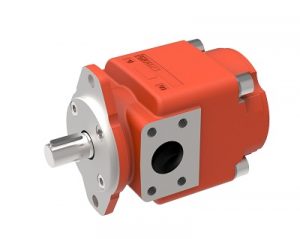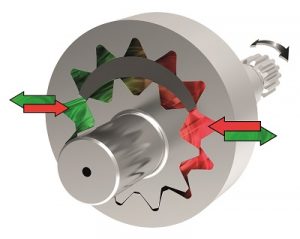“Less is more” is becoming increasingly important in hydraulics. With a focus on lowering Total Cost of Ownership, engineers are looking to downsize components and circuits while maintaining the same performance. Such efforts are primarily aimed at cost- and energy-savings.

New QXEHX series of internal gear pumps from Bucher Hydraulics offers 20% higher speed with lower operating noise. This facilitates downsizing the power train and using smaller motors and inverters.
As a result, there is a growing demand for pumps that run at higher speeds. That’s particularly true of applications with highly dynamic open circuits, such as injection-molding machines, die-casting equipment and metal-forming presses. In the power train, the pump, motor and inverter are interdependent, which means that changes to the pump have a direct influence on the other components. If the pump has a larger speed range, designs can use smaller electric motors and inverters.
With this objective in mind, the engineers from Bucher Hydraulics, Klettgau, Germany, have developed the new QXEHX series of internal gear pumps. Compared with the current QXEH, it offers approximately 20% higher maximum speeds, and it rounds out the company’s portfolio of QX internal gear units.
Early recognition of heightened performance demands, as well as extensive application know-how with the QXEH led to the new developments, according to Bucher officials. The need for higher speeds had previously been met by connecting an optional second suction port. The underlying principle of flooding the ring gear from both sides was retained, but it has been implemented through design changes within the pump body.
For instance, the cast contours of the internal suction and pressure galleries were improved and optimized. This alone meant that the speed range of the new internal gear pump could be significantly increased as standard without fitting an additional suction connection. The result is maximum speeds that are approximately 20% higher compared with those of the QXEH. This gives users an opportunity for successful downsizing, with lower acquisition costs and reduced energy consumption.
Higher performance, less noise
Speed and outlet pressure generally influence how loud a pump is. If speed rises, the noise level rises as well. Drawing on many years of experience with the previous series, the design team at Bucher Hydraulics overcame this issue by reworking the contours of the suction and pressure galleries.

The main feature of the non-compensated QXEHX is its smooth pressure build-up along the crescent, thanks to a long pressure build-up region. Free-running gears in precisely manufactured chambers, as well as symmetrical suction and pressure zones, ensure quiet operation.
Optimizing the flow galleries reduces the flow resistance, one result being that the noise level has been reduced by an average of 3 dB(A) compared with the QXEH. On top of that, the noise level in the upper speed range remains almost constant. The application therefore needs fewer sound-insulation measures, which saves costs for both machine manufacturers and end users as well as increasing operational safety and productivity.
The QXEHX’s high degree of operational reliability, according to the company, results from its basic non-compensated design, which allows for a very long pressure build-up region over the entire symmetrically arranged crescent. Using the “pinion shaft” design, the pinion and shaft are manufactured in one piece. In addition, the pump does not require any additional seals or compensating elements for internal sealing of the pressure zone.
Reverse mode
This design, typical for the entire QX series, has been proven as a highly productive workhorse in numerous applications over many years. This is particularly true when the pumps combine with highly dynamic servo- and reluctance-motors. In injection-molding machines, the QXEHX can easily operate in full-reverse mode several times per work cycle to relieve pressure in the system.
This is where the design features of the QXEHX internal gear pump come into their own, according to Bucher engineers. The pump does not require a defined preload pressure at the pump outlet, so it works reliably even when reversed with very low pressures at the outlet. The result is first-rate overall reliability. Other types of pumps need auxiliary valves to protect them against failure, but users can now save the costs of acquiring these valves as well as powering them. The design also offers ideal conditions for maintaining a perfect lubricating oil film in the bearing areas and gear parts.
Greater displacement, smaller size
Anticipating customer requests for the smallest possible compact components, Bucher Hydraulics offers the new internal gear pump in a wide range of displacements. Whereas only three displacements per frame size were available previously, users of the QXEHX can now benefit from larger displacements in smaller and also lighter frame sizes.
For example, applications requiring a pump with a displacement of 40 cm³/rev at a continuous operating pressure of 210 bar at the pump outlet, would need a Size 5 unit. Customers can now select a Size 4 pump instead. This saves about 30% of the weight of the pump and reduces costs. The “higher speed/lower displacement” concept also contributes to downsizing the power train.
Bucher Hydraulics offers overlapping displacements for the new sizes 4 and 5 (20 to 80 cm³/rev). Both frame sizes cover almost all typical applications that feature a highly dynamic open circuit, such as injection-molding and die-casting machines as well as metal-forming presses. Sizes 3 and 6 of the QXEHX will follow at a later date.
Bucher Hydraulics
www.bucherhydraulics.com
Filed Under: News, Pumps & Motors